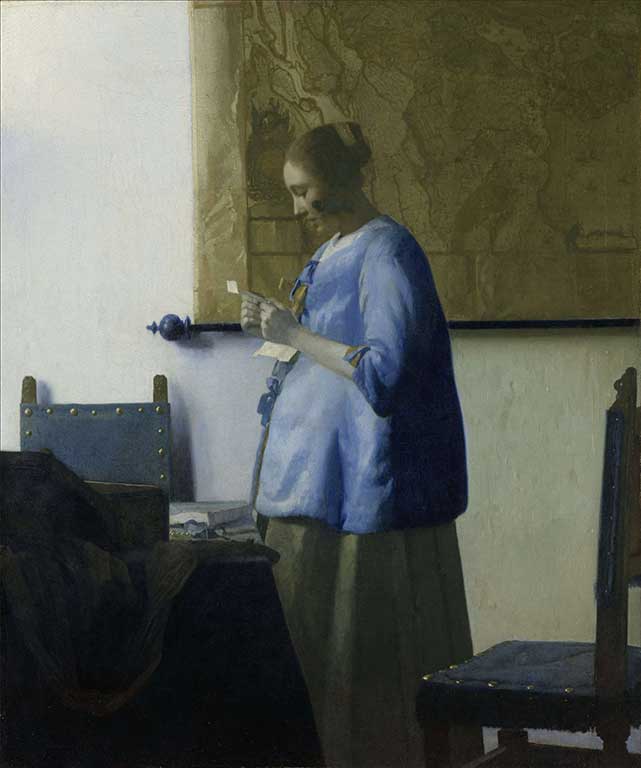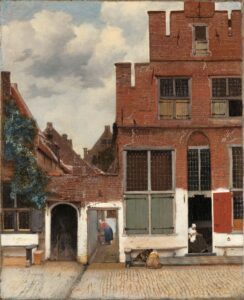
Woman Reading a Letter
Nancy Nesvet

Amidst a return to semi-normalcy as Covid restrictions fade, two blockbuster exhibitions on two continents, showing work by Johannes Vermeer at Amsterdam’s Rijksmuseum and Alex Katz at New York’s Guggenheim Museum treat domesticity and leisure. 98-year -old Alex Katz’s retrospective of his long painting career quite literally casts light on his portraits and social scenes. Reviewed in this issue by Marc Block, a writer new to the New Art Examiner. Gathering includes many portraits of his wife, Ada, painted during their long marriage since 1958, figures and faces he has painted over the years, and scenes of landscape in New York City, and Maine, where he has summered for many years.
Utilizing the bright sunlight of summer in Maine, often reflected off the water, Katz’s shadows are spare, a bit of grey or umber under the eyes, under the chin, an umber slash against the pink skin of his model and muse. His brightly colored landscapes, greens, yellows, pinks, seem almost impossibly bright for Maine, but not for his optimistic view of life in the country communities in which he paints his idyllic models. Katz’s study of the visible work inspired by “Salute” by Katz’s friend Poet James Schuyler, illustrating the “poetics of everyday” life is a gathering of his models, as was the community of faces on zoom that we saw during the pandemic.
Robert Storr has commented that Katz has created a record of quick things passing, compressing the image into a single optical perception. Yet it does not seem photographic, but rather painterly in its brushed application of shadows onto flat pale skin, or the lack of shadows on his treed landscapes. Inspired by billboards, magazines and movie screens, his canvases expanded with each decade as Katz progressed from painting on wooden boards to covering large canvases, the wide expanse of negative space around a single facial image leaving the model seemingly lonelier. Although those spaces work compositionally and geometrically, creating negative and positive space, the image, often cut off at odd points, like the lip line, in Ada 5 (2020) chin line, (Joan 2, 2020), above the eyebrows (Ada Evening, 2019) or in the screenprint of repetitive views of the same face, with different features cut off, (Vivien X 5, 2018) lack feeling. Often, faces seem too big for the canvas to hold, and for the audience to behold, like the billboards or the movies that inspired him. The Guggenheim Museum’s circling white ramps allowing viewing from below or above, seem like seawalls or terraces of a cruise ship or condo on the beach intensifying the sensation of seeing vacationers at the beach, and situating the large canvases in continuous white-walled, innocuous spaces.
In Katz’s portrait paintings of suburban women at play, at the beach, at leisure, and men dressed in office clothes or vacation khakis and collared casual shirts, the light is always bright; sunny skies prevail; the grass and full-leaved plants always grow green. The background is subtler, in grey greens, behind the group of women in LBD’s, (The Little Black Dress, 1960) as women came into the business world in force, documented by Katz. People in groups do not touch, standing with hands in pockets or folded in front of them, as in Seven People (1993) and later, the flat mounted sculptures show separate people. The later landscapes and genre scenes fill the canvas, as in Buttercup (2009) or Forsythia (1997) recalling the fields of paintings by Mark Rothko and other field painters and the all-over marks of Jackson Pollack seen by Katz early in his career. The poses of portrait models and the frontal position of trees, as in Tree 10 (2020) and plant life depicted make us believe this is all there is in the world. One portrait, one patch of flowers, strangely reflecting the narcissism of suburbanites, standing alone, concerned with only their patch of land, or personal appearance.
Vermeer’s paintings, full of props, could be movies. Many of his models are at domestic work, in the kitchen or the courtyard, attending to their daily chores, showing us a moment in their restricted lives, no less protected than those painted by Katz. Whether playing musical instruments, working in the kitchen, or turned away from us, we witness an activity that will go on. They are caught in the moment, a moment before photography, serving as an introduction to the activity that will go on that day, and be repeated day after day comprising a visual document of the lives of the villagers in Little Street, in Delft. That is the conundrum for me. How did Vermeer achieve the painterly vision experienced during hours of applying paint, and make it seem like one moment caught in the life of the model? Both Vermeer’s and Katz’s latitudes are the same, but Vermeer’s models, indoors with only natural light coming in seems greyed in comparison, with modest, unchanging light. How did he maintain the beam of unchanging light during those hours, continuing the process of applying paint, maintaining the direction and intensity of directed light that marks the paintings as only his, and how does he so well involve us in this northern, unchanging world so far from our own? How does he establish the empathic response of the viewer, the entrance of the audience into this little world so many years ago?
I grew up in the Brooklyn world that Alex Katz grew up in. My family retreated to summer at a country estate on a lake upstate. My city community literally moved together to Greenwood Lake, (painted by Alex Katz), where they partied together every summer, maintaining a suburban lifestyle unencumbered with household tasks or city concerns. Yet I feel more connection with Vermeer’s world.
Vermeer shows us the domestic life that people in his milieu engage in, literally providing a window onto their world, framing the interior and the woman at her task. Whether playing the virginal, the lute, the pianoforte, or putting on a string of pearls, attending to her chore as a milkmaid or accepting a glass of wine from an admirer, she (and it is usually a woman) performs her chores, identifying her and designating her work as that of a woman. This is Vermeer’s world, the world of Little Street that he inhabits and his familiarity with the people who inhabit his world. His admiration for them makes it unnecessary to dress them up or embellish them with costumes not their own. This is a Protestant world, with people concerned with simplicity and necessary work, Dutch art. Even his streetscapes, like The Little Street, (1658, Rijksmuseum), features a woman in the doorway mending, and another under an arch, attending to her washing. Those dressed in long coats and hats in View of Delft (c.1660-61, Mauritshuis Museum, The Hague) could be out for a well-earned Sunday stroll, after church. One woman dressed in a robe with ermine cuffs is attended by one of lesser class and means, showing the occupation of the working woman. I wonder at the woman seated in the office of the geographer. But the map is only of Holland. She does not venture far from her home. Yet that painting is so important in the oeuvre of Vermeer. He circumscribes the limits of his world, the domestic world. The median world depicted in “Woman Holding a Balance” (National Gallery of Art, Washington, D.C. constitutes Vermeer’s consideration of this world and the otherworldly, as the symbol of Christ, symbolic of the infinite world of God made finite in his son, illustrates the Judgement Day, when all balances, and inequalities between the two realms vanish. Using the scales, a domestic device to weigh produce, Vermeer sticks to his depiction of domesticity. The dark brown backgrounds, layered with paint of varied colors and hues, allow contrast with the bright colors imbued in the dress of his women allowing the concentrated light to beam through. “A Young Woman Seated at a Virginal”, (1670-72, National Gallery, London) illustrating intellectual love, sits under the triad of figures, reminiscent of religious paintings, as the central figure, dressed as a Dutch Master artist, stares lovingly at the woman who returns his gaze. In actuality, the painting she sits under is Baburen’s “The Procuress”, illustrating carnal love, reinstating the domestic world. Curiously, Vermeer’s “A Lady Standing at a Virginal” although not in this show, stands under Cupid, a Greek God, encompassing the painting, the scene, within the frame, approaching the infinite within the limits of the finite. Does Vermeer deny the Greek and Roman Catholic iconography in these two paintings, instead drawing attention to his domestic, simple illustrations as true depictions of life as it is and should be lived? Why do I care so about Vermeer’s people? Why am I so involved in his depictions of domestic practice? Why do I examine every bit of his interiors and exteriors? It is important to examine the world and question why I care about some art and what makes me care? That is a function of a Curator, one who cares for, not only the artist but the audience and how the art is received and interpreted, and it is the function of an arts writer.

Without caring or involving me, us, in his world, Alex Katz’s paintings are mere documents of lives I care nothing about. With no embellishment to the portrait, nor additions of elements to elevate the class of the person depicted, he takes the figurative portrait down to the basics; depicting the woman in a swimsuit or bare-faced, under sunglasses and perhaps a hat, and in so doing makes the portraits and figures, generic, suburbanites and Manhattanites all of upper middle-class America, playing at their summer camps. Vermeer, on the other hand, individualizes his people, gives them purpose and individuality. I do not know them, but want to. Although Katz, encouraged by James Schuyler, may have studied each daisy before it wilted, he saluted the field, filled with pretty flowers, which had no personality and which, only an observer, he could not have loved.
Katz’s world is not the normal world we seek return to after the pandemic. It is still the isolated world of the bubbles we joined and endured during the pandemic. Vermeer’s world, one of domestic ritual, necessary tasks, and minimal well-earned time for a Sunday walk pre-existed the pandemic, and is a world that ignores time. As we return to our lives, we remember moments of apprehension, relegated to the house, watching ourselves and others for signs of illness, watching for the one beam of light to make our existence brighter, anticipating the sun setting and rising again, returning to domestic tasks and communal gatherings. There is room for both Katz’s and Vermeer’s visions coloring our world, whoever and whatever world that is.

